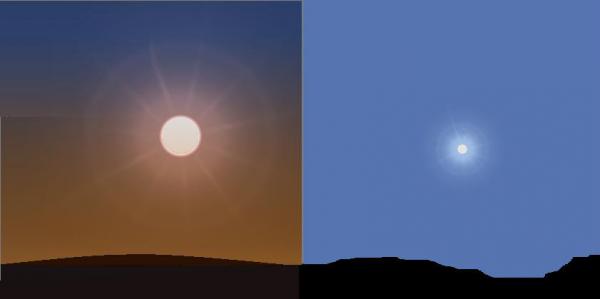BY LETTER
Apparent Brightness of the Local Sun
 Image from Steve Bowers | |
| As seen from a planet in the habitable zone, a red dwarf star seems much larger than a G-class star. On the other hand the red dwarf would appear less bright in visible light, because more of its heat is emitted in the infrared range. However the total amount of heat received by the planet would be the same in both cases | |
Inveterate space tourists in the Civilised Galaxy have the opportunity to compare the brightness of various stars from the surface of any number of terraformed planets; those planets which receive approximately the same amount of energy from their sun as Old Earth (the so-called 'comfort zone') are the most easily terraformed, but the appearance of the central star is often very different.
Planets in orbit around a red dwarf have to be much closer to the cooler star than those around sun-like stars; these planets are usually tidally or harmonically locked to the star, so the movement of the star in the sky is unusual. Being cooler, a red or orange dwarf star has to be larger in the sky than the Sun is in the skies of Old Earth; even Tau Ceti is 15% larger in the sky of Nova Terra than Sol would appear. Similarly those planets around hotter stars (such as Daedalus) have to be much further from the central star; Pi 3 Orionis is 20% smaller in the sky on this world.
However the sunlight is actually brightest on G-type stars (at least to those clades with traditional baseline human spectral perception) due to the large amount of non-visual radiation from hotter or cooler stars. Habitual tourists become aware that the visual magnitude is different to the luminosity, and the light from a sunlike star is rich in the visual.
A red dwarf gives off more energy in the infrared than our sun, so if you had a star which had the same visual magnitude as our sun the amount of energy received in total would be greater, although we would not be able to see it all; in the same way a blue star would give more energy in the UV end of the spectrum, and so a star that appeared to be the same visual magnitude as the sun would in fact be giving a lot more invisible energy...the total luminosity would once again be greater.
Putting it another way, any planet around another star which receives enough starlight to have Earth-like temperatures will get more of that energy in the form of I-R or UV radiation - (unless the star is a very sunlike yellow G-type dwarf) - this will lead to the conclusion that for a planet with Earth-like temperatures, visible sunlight will be dimmer for both a hotter or a cooler star.
Tourists to very sunlike stars like 18 Scorpii are often surprised at the brilliance of the light from the sky, and traditional retrostyled 'raybans' are a popular accessory on these worlds.
Related Articles
Appears in Topics
Development Notes
Text by Steve Bowers
Initially published on 05 January 2004.
Initially published on 05 January 2004.
Additional Information
Related: The Sky on Alien Worlds






